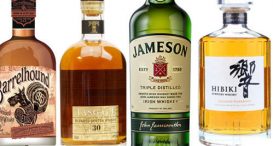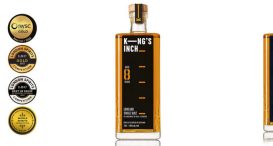A look at whisky as an investment with Andy of Whisky Highland
let’s begin
As a whisky collector of around seven years I have often wondered if some of my precious liquids were of investment grade or not. This led me to speak to the knowledge base that is Whisky Highland about whisky as an investment.
It all came about rather quickly, I had been reading a lot about using whisky as an investment mechanic, something increasingly more prevalent in Asia and the more I read, the more I wanted to know and understand so I got in touch with Andy Simpson, founder of Whisky Highland to find out more.
GreatDrams: Firstly, what drew you into the world of whisky?
Andy: I’ve been collecting since I was 16 years old, my dad bought me a Collin’s Gem book for whisky and said that every birthday, Christmas and special occasion we will swap bottles of whisky and eventually we will try whiskies from every distillery in Scotland. That made me quite popular as I was the only kid on the block who got a bottle of whisky rather than an Easter egg.
GreatDrams: Wow, that sounds like a pretty cool adventure the two of you set out on, did you drink all of them?
Andy: When you’re that age, the whisky itself is actually quite harsh on the palette, you’ve not developed as much as the typical whisky drinker has so I started keeping more than I drank, in essence, starting the collection.
GreatDrams: So I’m taking it that these early experiences led you to working within the whisky industry?
Andy: My original career was as a corporate banker, so was used to dealing with high level investors but ended up giving that all up to consult with a variety of distillers in the industry and to run the Whisky Highland website. At last count, the site had around 70,000 bottles listed.
I also do a lot of brokerage and building collections, the minimum transaction is £10k, and we deal with mostly high net worth individuals and companies looking to drink, collect or invest. It is great as we are dealing with lots of rare editions.
GreatDrams: Now an obvious one, how do you get into whisky investing?
Andy: Firstly you have to love whisky but, from a pure investment perspective, you have to be exceptionally focussed. There is a balance in the investor / collector relationship; you become passionate about whisky so you collect, often people have 300/400 bottles from specific distilleries and as a collector you want every bottle that every existed. On the flip side, an investor is not looking at that, they need to think about the return.
GreatDrams: You must invest in quite a few bottles then? What makes you buy?
Andy: I have tried around 5,500 single malts, I typically buy two of everything; one to drink and one to keep. I do buy bottles I think will go up in value or sometimes what tickles my fancy if they are interesting or I’m just plain curious.
GreatDrams: So what makes a whisky investable?
Andy: One man’s investment today is another man’s drink tomorrow. The focus has to be on the quality of the liquid. Virtually everything from Brora and Port Ellen are seeing significant increases. Some Dalmores and old Taliskers are going up in value. Get limited editions, annual releases, especially Macallan for example, some of the best returns are the bottles where you have to go to the distillery to buy, it limits who can feasibly obtain a bottle in the first place.
It is simple supply and demand dynamics, Macallan’s Easter Elchies Cask release last year was £185 per bottle, and now is already around £600 as only 380 or so bottles were released. More and more bottles are coming to market through many different auctioneers. This increased supply continues to be mopped up by an ever growing army of enthusiasts.
For investment grade whiskies, look for iconic and / or silent distilleries. The big opportunities for 2014; silent distilleries from independent bottlers, they are increasing substantially as these are the last few places to get old distilleries and rarer stock. Just nothing to do with jewels or big decanters.
GreatDrams: What makes a whisky not investable?
Andy: The prevalence of NAS nowadays means that the vast majority will not be of investment quality, also, those released with jewel encrusted crystal decanters covered in gold are not investments, they are trophy pieces. For example, the Richard Patterson Collection in Harrods, costing £987,500, is never going to be an investment, it is a trophy, a legacy and a culmination of a great man’s work. Collectable? Yes. Investment? Absolutely not.
Here’s an example; Tribute to Honour Chivas bottle. At £150,000 it’s not an investment, the vast majority of the value is in the bottle not the liquid. This is not an expensive bottle of whisky, it’s an expensive whisky bottle. Let’s not forget whisky is a drink. If you open one of these what do you do with the empty? Historically there is virtually no potential for those things to go up in value, not sure if many even get sold.
Highland Park 50 should have fit the mould as a great investment, they’re a great iconic distillery, only 200-odd bottles, but the story is about the bottle’s designer, Maeve Gillies and how she went about designing the bottle but it has to be about the liquid, what else matters?
Anecdotally, that bottle retailed at £12k when it went into stores, initially just Harrods then worldwide but the latest one sold recently at auction for ‘just’ £5.8k so you can also lose out.
GreatDrams: Are retail releases worth looking at?
Andy: There is not much coming out from a retail perspective that is investment quality, some Diageo annual releases but they are proactively removing secondary market gains buy pumping the price higher upon release.
There is huge potential for Macallans from the 1970s, such as the 18 year old, incredible stuff, most of the newer releases (other than the annual Easter Elchies Cask release) are not really of investment grade either, especially since they got rid of age statements, from an investors perspective the 1824 Series is a ‘no-go’ zone.
The thing is, you can go to a normal retailer as there are some interesting bottles coming out but the main place is auctions … that’s where you will find older, rarer whiskies, you have Christie’s, Bonhams, etc. but online there are loads. Check out www.scotchwhiskyauctions.com , www.whisky-onlineauctions.com, http://whiskyauction.co.uk for example, all these sites are increasing liquidity in the market to make rare and old bottles more readily available.
In today’s modern market it is often not practical to go to old a traditional auction house, so online adds that degree of flexibility.
GreatDrams: So what brands are the best sellers then?
Andy: In terms of pure volume, Macallan is the biggest seller by a country mile, followed by Ardbeg, Glenmorangie and even Bruichladdich. There are a lot of Bruichladdich products and a huge amount of releases. I think Bruichladdich brought out around 48 or 49 releases in 2009, so it floods the market. Their older vintages are more interesting, 125th anniversary bottling is desirable but lots of their others are generic.
Bruichladdich is more for collectors. You can collect for years as there have been so many bottles released which can be fun.
From an investors perspective, Brora tops the list along with many other silent distilleries.
There needs to be a big word of caution as well. Just like any investment, values can decrease (as Macallan values are experiencing right now) as quickly as they can climb. Buying the ‘wrong’ bottles can be disastrous, some have seen an 80% decrease in value over recent times.















2 thoughts on “A look at whisky as an investment with Andy of Whisky Highland”
Hi Greg. You might be interested to know I’ve published a guide on this- Scotch Malt Whisky Investment and Enjoyment by Michael Ross on kindle. Slain the!
Sir
How are you? Please advise if it’s worth swapping/exchanging some unopened bottles for the Port Ellen 35 14th release.
Thanks,
Thomas